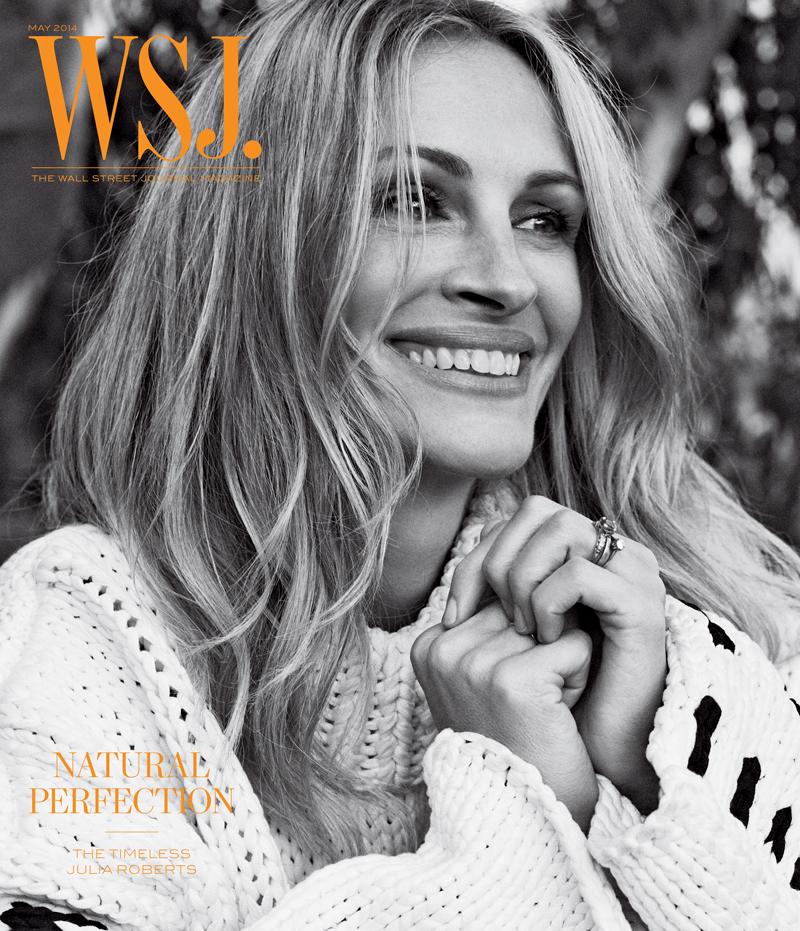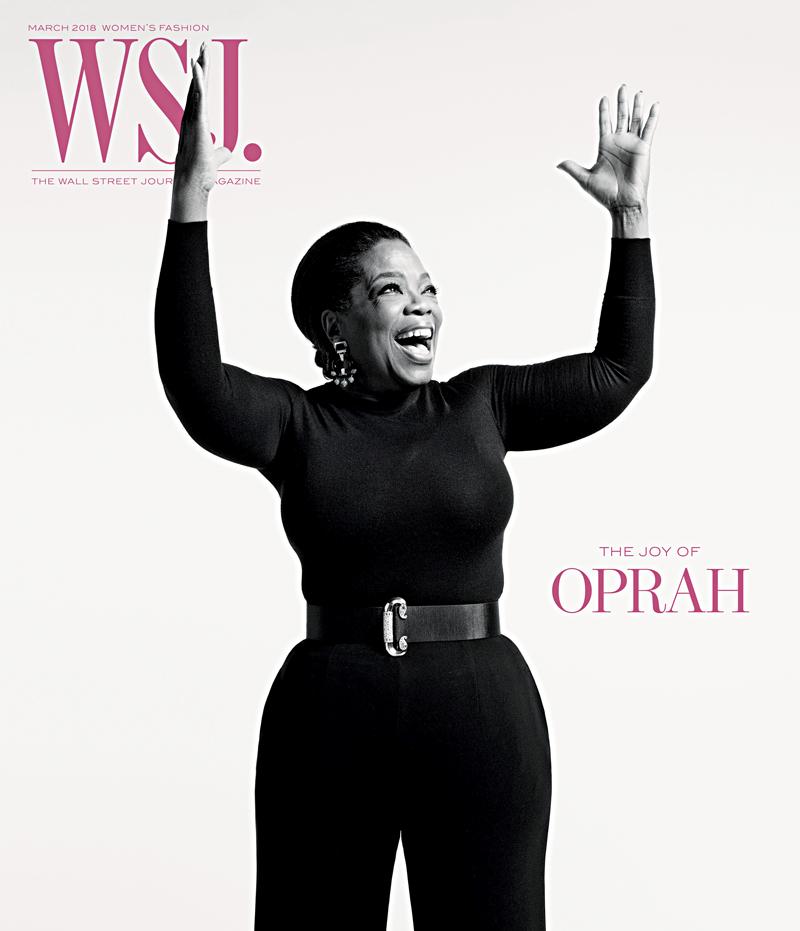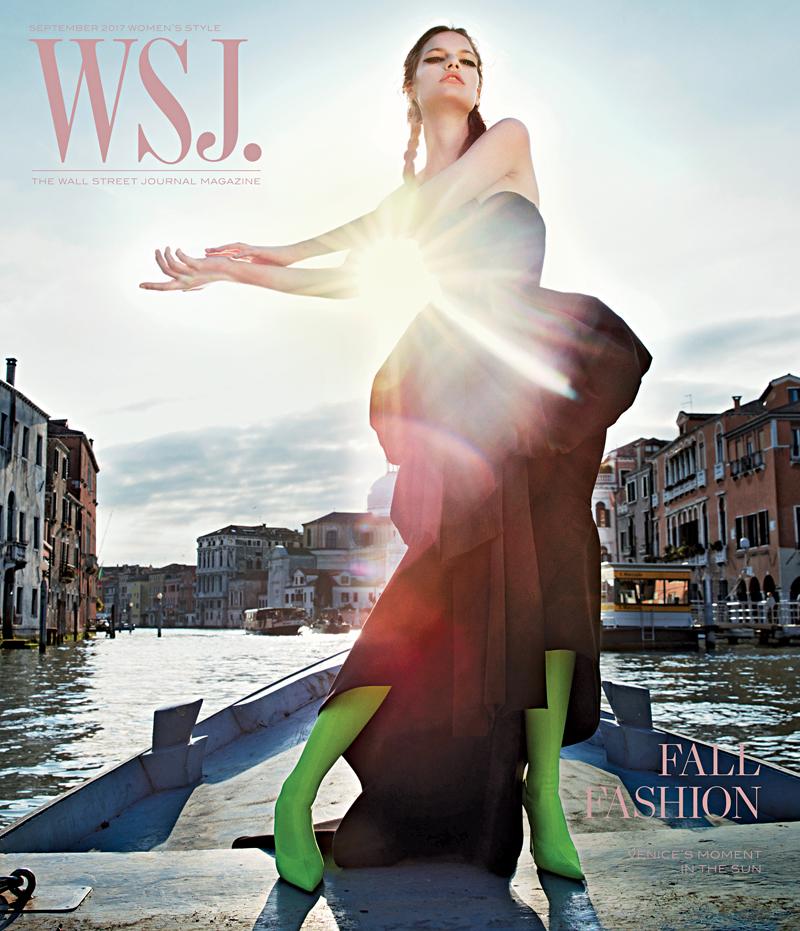It’s been five years since Kristina O’Neill unveiled her first issue of WSJ., and the mag is simultaneously celebrating another big milestone—its 10th anniversary. O’Neill fills us in on her successful tenure at The Wall Street Journal’s very chic sister pub.
What are some highlights from your stint at WSJ. so far?
Five years flew by! I remember putting the first one together like it was yesterday. A lot of the franchises and visual language we launched in my first issue are still going strong today. It’s exciting to see a lot of things really calcify and click. Also, I’m really grateful that I’ve had the time to put a lot of long-lead, big ideas into play and see them through. Our March cover is Oprah Winfrey, and that’s an idea that went on our cover bucket list many, many, many years ago.

WSJ.
How did you snag Oprah?
The timing just aligned—I keep saying, “Forget 2020—2018 is Oprah’s year.” She embodies power, success, empathy, being self-made, all the things that our culture is hungry for, and all that the WSJ. reader wants. We work with an amazing celebrity/entertainment bookings director, Andrea Oliveri, at Special Projects Media; she and I have always had similar tastes about celebrity when we do celebrity. The luxury we have at WSJ. is that we don’t have to put a celebrity on the cover every month, so when we do, we really want to make sure they embody the messaging we’re trying to tap into. I’m sure there were a lot of prayers and e-mails that went into getting Oprah [Laughs], but the stars aligned. Having her on our March issue is meaningful because it’s a fashion issue, and I think the fashion industry really respects and admires Oprah. It was exciting to work with [photographer] Mario Sorrenti and [stylist] George Cortina on the shoot to really transform Oprah into the powerful goddess she is.

WSJ.
When you started this role, you talked about freedom of working on a title with a lot less history than where you were before, at Harper’s Bazaar. How has that panned out?
To be clear, The Wall Street Journal is an institution. It’s 128 years old—that’s an amazing statement in and of itself, because the trust factor is there. It’s this packaging for us to exist in. But the magazine itself is only 10 years old, and it got off to kind of a slow start. It was only four issues per year when it launched, and it slowly increased and increased. When I took over, it was the first year WSJ. published 12 issues. It’s not like you’re up against these historical dictates that magazine or fashion fans expected; there was no visual language we had to subscribe to. I felt like we had the freedom to work with a whole new regime of writers and photographers. But, that said, a lot of our creative direction came from how the newspaper looks.
How so?
We use some of the same fonts the paper uses, called Exchange, and we introduced the “What’s News” front-of-book section, which is a cheeky play on the “What’s News” column that’s on the front page of the paper every day. So there are things where we played to our history. But because we didn’t have the same style dictates that shadow other magazines through their existence, I feel really blessed to have come in almost from scratch, but with a knowing look at the newspaper’s identity.
What other luxuries does WSJ. enjoy by not being beholden to newsstand sales?
The luxury is truly in the cover choices. I love that, across an entire year, we can kind of tick all the buckets that we know our readers are interested in, and the things we stand for. Obviously, there’s fashion and celebrity, but it’s also art, culture, tech, sports, music, design, architecture. There’s an awesome freedom in that. You’re not thinking, “Okay, it’s our turn to have blank celebrity,” and waiting in this round robin for your cover with the biggest newsstand mover of the moment. We can decide to put Oprah on the cover one month, and a chair or a penguin on the cover after that. That’s what’s really special about WSJ.—we’re able to introduce an element of surprise each month.
What’s the biggest risk you’ve taken during your time at WSJ.?
I sort of live on intuition, trust my gut, and follow my instincts, so I don’t know if I would ever consider that to be risky. We’ve certainly put some surprises on the cover—when we featured James Corden, it was his first major magazine cover. Inez and Vinoodh shot him, we covered him in fake tattoos, and he joked that he’d been influenced by Harry Styles’ tats, and then James and Harry had a whole Twitter exchange about that.
How has the role of an EIC changed during your five years in that capacity?
Certainly at WSJ., the newsstand metric isn’t as meaningful as it once was. The industry as a whole is relooking at how you measure your success—if it’s not just newsstand, there are other ways to know if your readers are engaged and enthralled by the content you’re publishing. For us, we’re thrilled that the weekends we’re out [the paper] sees a bump [in subscribers]; subscription conversion is another thing we look at. When our articles can convert people who’ve come in through a magazine channel, and then convert to Wall Street Journal subscribers, that’s a thrilling number to see go up and up. That’s a way I know, “Oh, we made a really smart choice, and I’m so happy we did X story.” Obviously, engagement on social is really important. To see our numbers rise steadily over the years, whether it’s Instagram, Twitter, or Facebook. Events are another measure—everyone wants to have a touchpoint with content creators.
How have events become an increasingly more important part of the equation?
For us, launching the D.LUXE conference in October was hugely gratifying, and an amazing opportunity to bring the people we put in our pages monthly to a stage, to have conversations—we Facebook Live-d it, too, and numbers were huge, especially when Jared Leto was onstage. Also to see the community around our content—people wanted to stop and talk to Cindy Crawford or Scooter Braun. Also, our Innovator Awards event continues to be massively rewarding; it really showcases the intersectionality of what we do. It’s not an echo-chamber event; it’s not fashion people talking to fashion people. You have the best chef in the world with an Oscar-winning actress, a Grammy-winning musician, a designer—to these people together, striking deals and making plans, that’s a payoff not just for us, but for them as well.
Has WSJ.’s readership expanded during your time there in any surprising ways?
Anecdotally, yes. We know our social engagement profile is probably the opposite of the demographic breakout of The Wall Street Journal’s. We’re definitely engaging with a younger, equally female and male audience at WSJ. Seeing the fashion community really get behind what we’re doing, and deeper commitments from all the big, core fashion brands in terms of advertising is another major marker of success. Our September fashion issue was our biggest issue, ever, which was really exciting. We also see audiences that didn’t really know what to expect from WSJ. come on board—the entertainment industry, too. Celebrities who didn’t really think of WSJ. as a “must-do” cover are really seeing the halo of being a part of WSJ.

WSJ.
You were able to touch on various topics while you were at Bazaar, but has the scope been even wider at WSJ.?
Definitely. Design is a personal passion point for me—our readers are affluent people, and they’re always looking for the newest architect or hot interior designer. Food is fun; I think we’ve seen celebrity chefs rise and rise in culture in the past five to 10 years. Tech is also the biggest area where we’re been able to explore the tech space in a very WSJ. way. Having [designer] Jony Ive on our cover was a real triumph; we did him in a way that most magazines covering tech wouldn’t do, tapping into this really interesting, philosophical side of Jony. I also love how we cover fashion here; not having 15 fashion stories in the well really focuses the one or two that we end up doing. That messaging is really important—cutting through all the noise, and distilling it down. It’s also interesting to have fashion in the context of culture, and not the other way around.
Could you ever imagine leaving print altogether and taking on a purely digital role?
I think we’re all watching the media industry evolve rapidly around us. For now, I’m sort of focused on getting the April issue out. [Laughs] But in terms of a long-term plan, digital will obviously become ever more important. Seeing print evolve within that context is exciting right now. We’re refreshing our digital platform later this year, and considering how magazine thinking can exist offline is something I’m fascinated by. I don’t know where this will take me, but I’m obviously open and I love learning.
Does your tween daughter read print magazines, and do you encourage her to do so, to keep print alive and all?
Yeah, she’s very proud of her mom, and she loves it when the magazine comes home. But she’s 11, so I don’t know if she’s really devouring it. It’s fascinating to see her content consumption—she’s on YouTube, Snapchat, Instagram. There aren’t many magazines targeting her; she gets Time for Kids, and reading and being absorbed in culture is where a love of print stems from, and I hope she’ll get there. Right now, she’s still reading her books for school! [Laughs]
You spent time as a style editor at some beloved local titles—New York and Time Out New York—early in your career. How was that, and is it at all relevant to WSJ.?
I found it thrilling to be at a weekly. You didn’t have time to overthink, and aspects of that apply to what we’re doing here. We work one, three, six, and 12 months out, so we’re always working ahead, and from working at a weekly, I learned that you can’t start from scratch every Thursday after your section ships. You have to always be thinking short, medium, and long term.
In college, you had a part-time gig as Candace Bushnell’s assistant. Do tell!
Working for Candace was amazing. She was at the height of Sex and the City, and she was writing her column, the book had just come out, but it hadn’t yet been turned into a series. She was in the initial meetings with Darren Star; they were spitballing ideas with Sarah Jessica Parker. Candace was such a creative, clever woman, and I learned so much from working with her. Candace’s ear for dialogue was so unique—she’d come home with a cocktail napkin, or pockets full of crumpled-up cocktail napkins, scribbled with things she’d heard that night—some outrageous thing someone said to her at a dinner party—and I’d type them up as dialogue runs. Candace also wrote every single day. It wasn’t like, “Oh, my column’s due, what am I going to write this week?” She really honed her craft in a way I respected.

